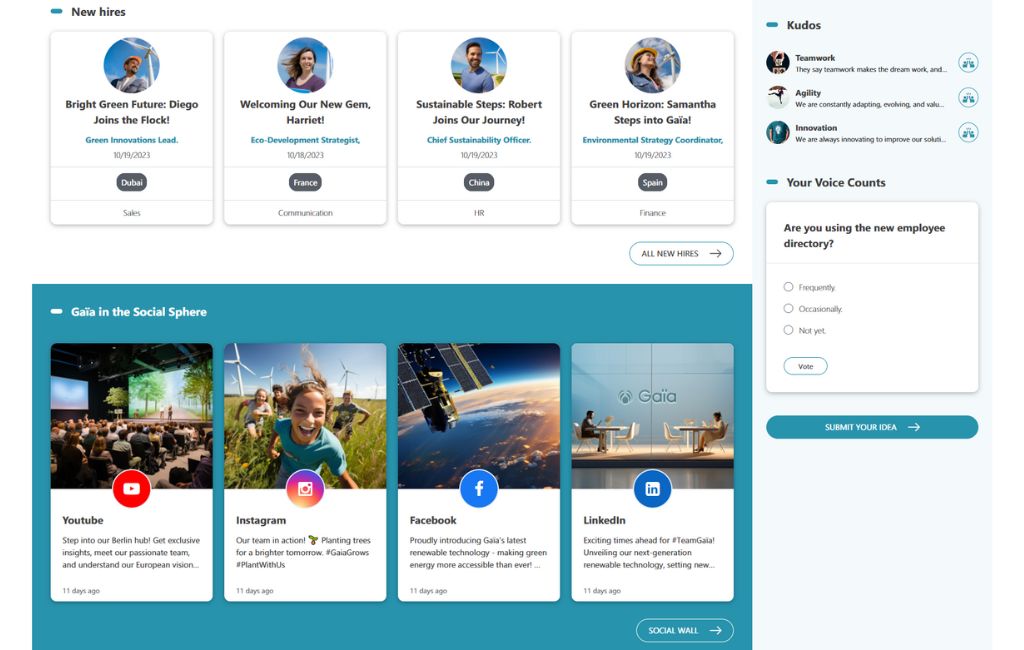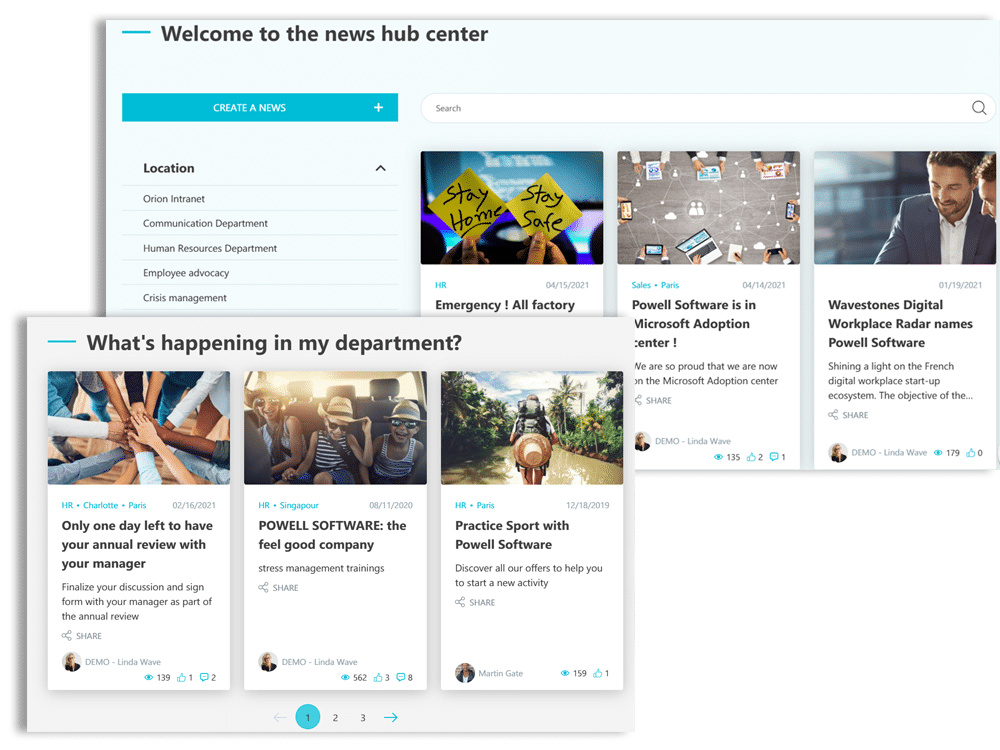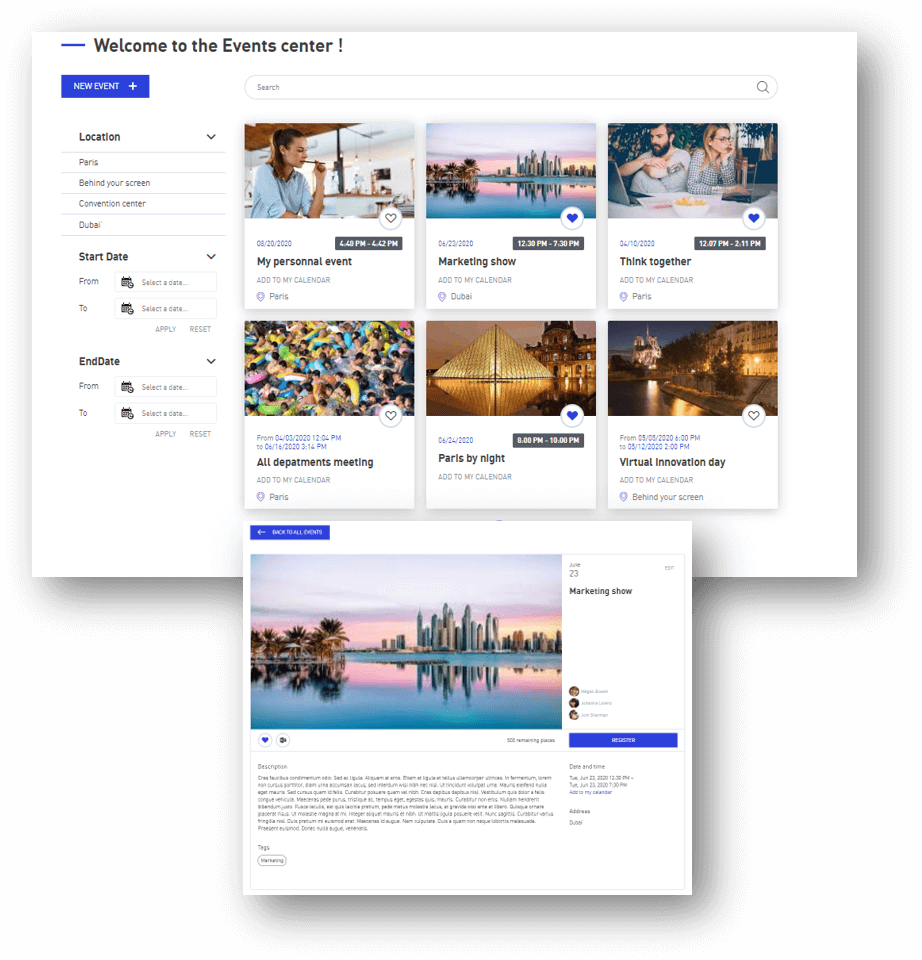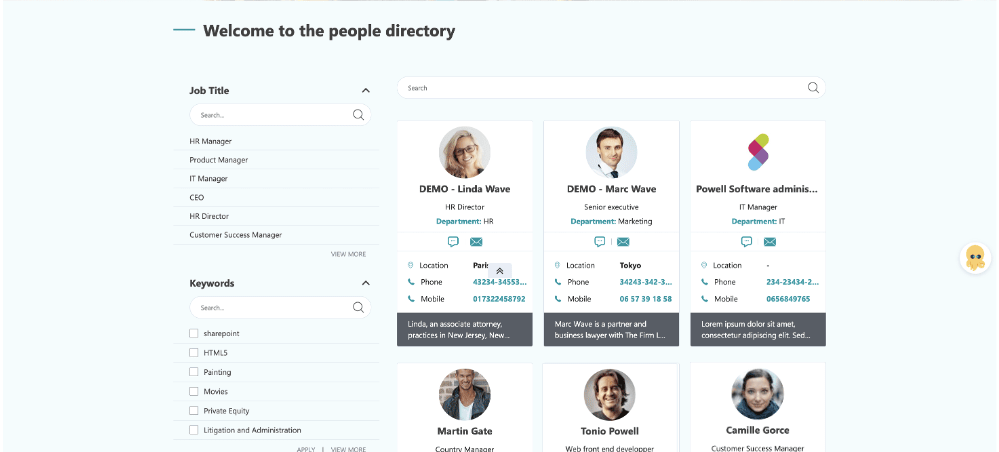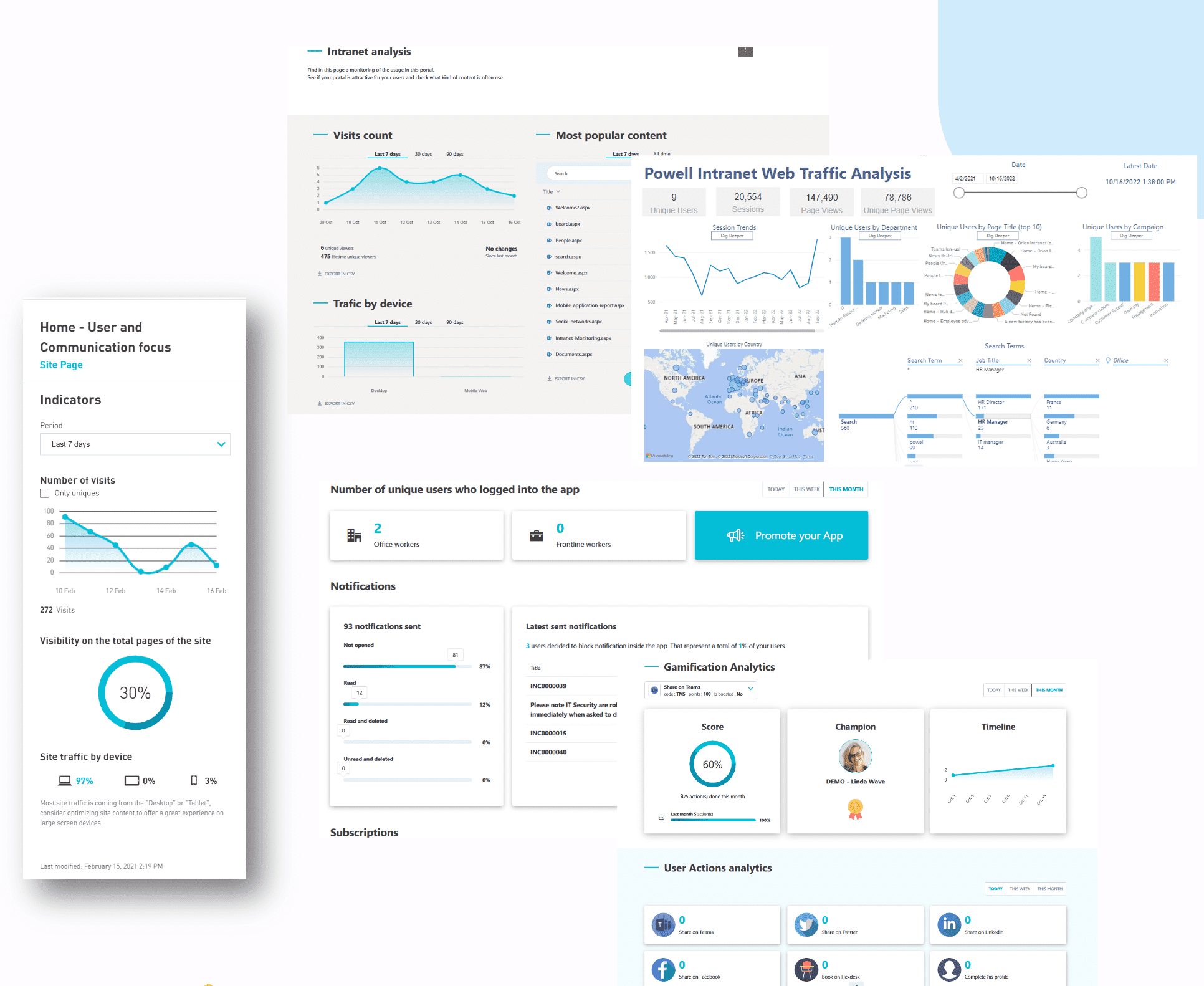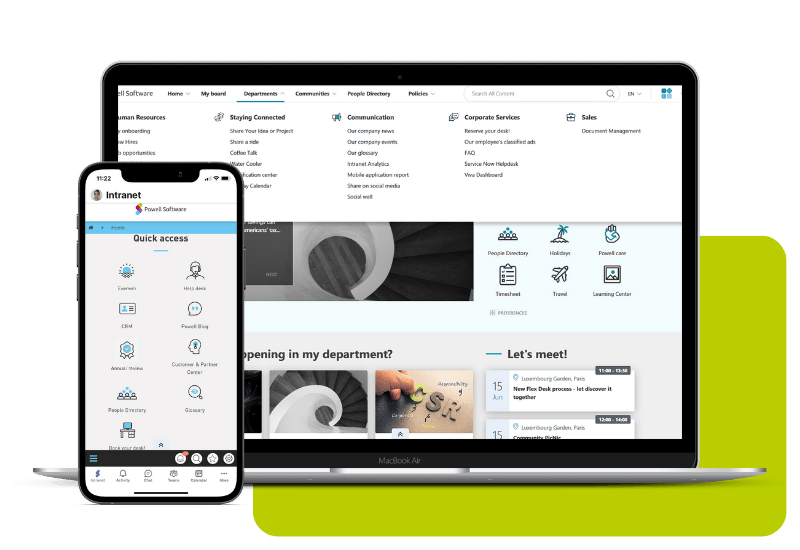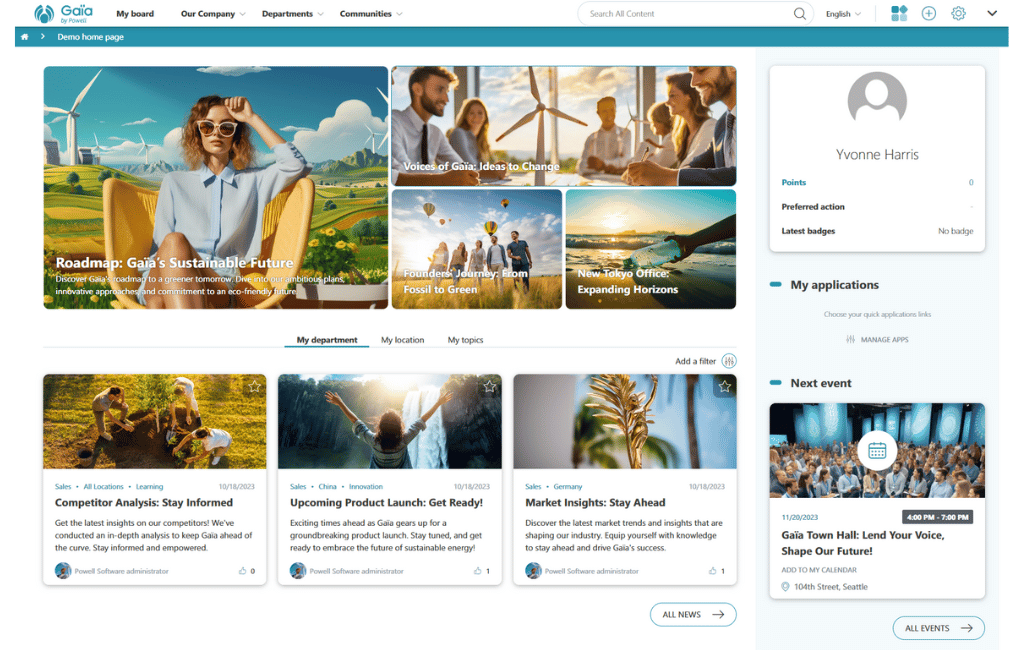What is an intranet?
An intranet is an internal network that connects people and resources within an organization. It facilitates communication and collaboration between members of the organization and typically only allows access to authorized users. It can be used to share documents, provide access to applications, host websites, and provide a platform for collaboration.
Intranet networks are usually secure and can be accessed from any location, allowing remote access to the company’s information. This enables the streamlining of operations across employees and teams as information can be accessed on the go.
Why use an intranet?
Intranet software is a tool for creating and managing an intranet. Various intranet software providers offer varying levels of functionality and intranet features that can help manage a company’s intranet.
The software provides a secure platform for sharing resources and data with employees. It may include file sharing, messaging, collaboration, and search capabilities. Some intranet software can host company websites and help with project management and task organization. The essence of the software is to help companies harness the full power of intranet solutions.
What are the advantages of an intranet?
1. Streamlined Communication
Intranet software facilitates centralization, making it easier for employees to connect with colleagues and access important information. This can include everything from internal messaging to document sharing and project management.
An intranet makes it easier for teams to communicate, share documents, and collaborate on projects, regardless of location or time zone. This improved communication can lead to better decision-making, greater efficiency, and enhanced service.
2. Enhanced Security
This digital solution can help companies protect sensitive information and keep unauthorized personnel from accessing confidential data. User authentication and access control can secure intranets so only authorized personnel can access sensitive information. This can help minimize the risk of data breaches and protect the company’s confidential information. If security is a priority, a SharePoint intranet is a good solution.
3. Increased employee engagement
Intranet solutions enhance employee engagement by providing employees with tools to collaborate, share ideas, and stay updated on company news. This can help keep employees informed and engaged, resulting in higher morale, greater job satisfaction, and improved performance.
4. Cost Saving
Intranet software also helps companies save money by reducing the need for physical storage and paper-based processes. As intranets can store and share documents electronically, there is a reduced need for printing, paper, and other physical media. This can help reduce costs associated with physical storage and paper-based processes, saving the company time and money.
Intranet: what are the disadvantages?
Intranets, while valuable collaboration tools, can come with some drawbacks:
- Information overload and usability: A central location for information can be a double-edged sword. It can overwhelm employees with irrelevant content and make finding specific details difficult if not well organized. A cluttered cms intranet with a poor search function can lead to frustration and employees abandoning it altogether.
- Security risks: Centralizing data creates a bigger target for hackers. Robust security measures and employee training are crucial to minimize the risk of a breach.
- Cost and maintenance: Setting up and maintaining an intranet requires ongoing investment in software, hardware, and IT support.
- Low adoption: Employees who find the intranet challenging or irrelevant to their daily tasks may not use it. Encouraging user feedback and tailoring content to employee needs is critical to driving adoption.
- Accessibility: Not all employees may have access to a computer or reliable internet connection. This can prevent some people from using the intranet and limit its effectiveness as a communication tool. Ensure you choose a provider that offers a mobile intranet option.
How do intranets work?
An intranet is a private network contained within an enterprise or organization. It uses the same Internet protocols and services, such as the Hypertext Transfer Protocol (HTTP), as the public Internet but is only accessible by authorized users within the organization or enterprise. Intranets are also used to host private websites accessible only to authorized users.
Firewalls and other security protocols protect intranet networks to ensure only authorized users can access the content. Authentication is commonly used to confirm users’ identities before allowing them to access intranet resources. Access control lists also determine which users can access which resources.
How to implement an intranet?
- Understand your organization’s specific needs and goals. Based on this, decide which platform you will use for your intranet.
- Set up user accounts and configure security settings.
- Create the intranet’s structure, including navigation and content organization.
- Design the look and feel of the intranet, including the layout, color scheme, and branding.
- Test the intranet before launching it to ensure it is functioning correctly.
- Provide training and support to users to ensure they understand how to use the intranet.
- Regularly monitor the intranet to ensure functionality and security.
What features should an intranet include?
An intranet should include helpful features for the company and its employees.
Document management
This allows for the storage and organization of documents and should include the ability to assign permissions to different levels of users. This will enable employees to easily access and share documents while ensuring that sensitive information remains secure. It should also provide version control and audit trails to track document changes.
Communication tools
An intranet platform is incomplete without advanced tools to improve internal communication. These should include messaging, forums, media-sharing tools, and a comment system to allow employees to communicate with each other in an organized and efficient manner.
A corporate calendar
A corporate calendar to keep track of important events and deadlines is highly beneficial. This will help employees stay organized and informed about company activities.
Employee directory
An employee directory that allows users to search for contacts by name, department, or other criteria will facilitate quick communication between employees and teams.
Task management
An intranet should include a task management system to track and assign tasks. This will help ensure that tasks are completed on time and that everyone involved knows their responsibilities.
Reporting and analytics
An adequate intranet solution should include reporting and analytics capabilities to provide insights into employee performance and productivity. This will help identify areas for improvement and ensure that employees meet their targets.
How to ensure an intranet’s security?
Ensuring an intranet’s security is essential to protect the company’s data and resources and can be achieved by implementing various measures.
- Install a firewall and use anti-virus software to protect the network from outside attacks.
- Use encryption to protect data transmitted over the network. Establish a secure password policy and regularly monitor the system for suspicious activity.
- Utilizing two-factor authentication and other multi-factor authentication methods is a great way to ensure that only the right people can access the system. Additionally, IPS and IDS systems can detect and stop malicious traffic.
- Review and update the security policies and procedures regularly to ensure the system is current. Then, periodically test the system for any vulnerabilities to further strengthen the intranet’s security.
Intranet best practices
- Keep it simple: Intranets should be designed to simplify things, allowing users to navigate and access the information they need quickly. This can be achieved by avoiding cluttering the interface with too many images or links and creating a clear information hierarchy.
- Make it accessible: Ensuring that the intranet is accessible to all users, regardless of their ability, is crucial in providing a positive user experience. This includes ensuring screen readers can read all text and that all images have appropriate alt tags.
- Keep it up to date: The intranet must be updated with the latest information. This ensures that users can access current information to make informed decisions.
- Allow for user feedback: Allowing users to give feedback and suggestions is essential to ensure the intranet meets user needs. This can be done through surveys, polls, and other ways of collecting user feedback.
- Monitor usage: Monitoring usage can help identify areas needing improvement and ensure content is relevant. This can be done by tracking page views, time spent on pages, and other metrics
How to boost the adoption of a newly created intranet platform?
Making the intranet easy to use and understand is essential to ensuring employees use it. A cumbersome and non-intuitive platform may significantly deter employees and cause reluctance to accept it.
- Providing training to ensure that employees are familiar with the platform is a surefire way to build enthusiasm about the use of the platform
- Employees can also be encouraged to use the intranet by offering incentives and rewards for using the platform
- Regularly updating the intranet and utilizing the best providers with the most enhanced and user-friendly features is a great way to sustain the acceptance and utilization of newly integrated intranet platforms.
How to analyze and measure the benefits of intranets on a company’s productivity?
Measuring the impact of the intranet on the company’s productivity is essential as it helps to ascertain the cost-effectiveness and overall benefits. Here are a few ways to analyze the benefits of the intranet solution.
Gather feedback from employees
Ask employees how they use the intranet and how it is helping them work more efficiently. This can be done through surveys or focus groups.
Track usage statistics
Monitor the number of active users, pages viewed, and features used. This will help you identify which features are used and whether they increase productivity.
Measure time saved
Calculate the time saved by using the intranet instead of more manual processes.
Track employee engagement
Use employee satisfaction surveys to determine how engaged workers are with the intranet.
Monitor changes in business outcomes
Analyze data such as customer satisfaction ratings, sales figures, and operational costs to determine whether the intranet is improving overall business performance.
Intranet, internet, and extranet – what is the difference?
Intranet, internet, and extranet networks differ in purpose and access privileges. All three networks can be used to share information and resources. Still, the extent of access and the level of security vary, and herein lies the palpable differences between them.
An intranet is a private network accessible only to a specific group, such as employees of a particular organization. It is used to provide secure internal communication and collaboration among organization members. It typically includes file sharing, messaging, and web-based applications.
On the other hand, the Internet provides the same services. It is used to connect computers and devices worldwide, allowing users to share information and communicate with each other. The Internet is also the platform for many popular services such as email, social media, and search engines; this differs from the intranet, which only grants authorized internal access.
An extranet is a private network accessible to a select group of users outside the organization. It is often used to share data and resources with customers, suppliers, and business partners. It can also provide access to web-based applications and services unavailable on the public Internet.
In summary, an intranet is a private network for a specific organization, the internet is a public network accessible to everyone, and an extranet is a private network for a select group of users outside the organization.
Is a company intranet still a good internal communication and collaboration tool in 2024?
Yes, and this is owing to the numerous benefits offered for communication and collaboration.
Intranets may enhance operational flow through document management, workflow automation, and online collaboration tools. They can also be leveraged to offer secure access to cloud-based services and applications to enhance productivity.

